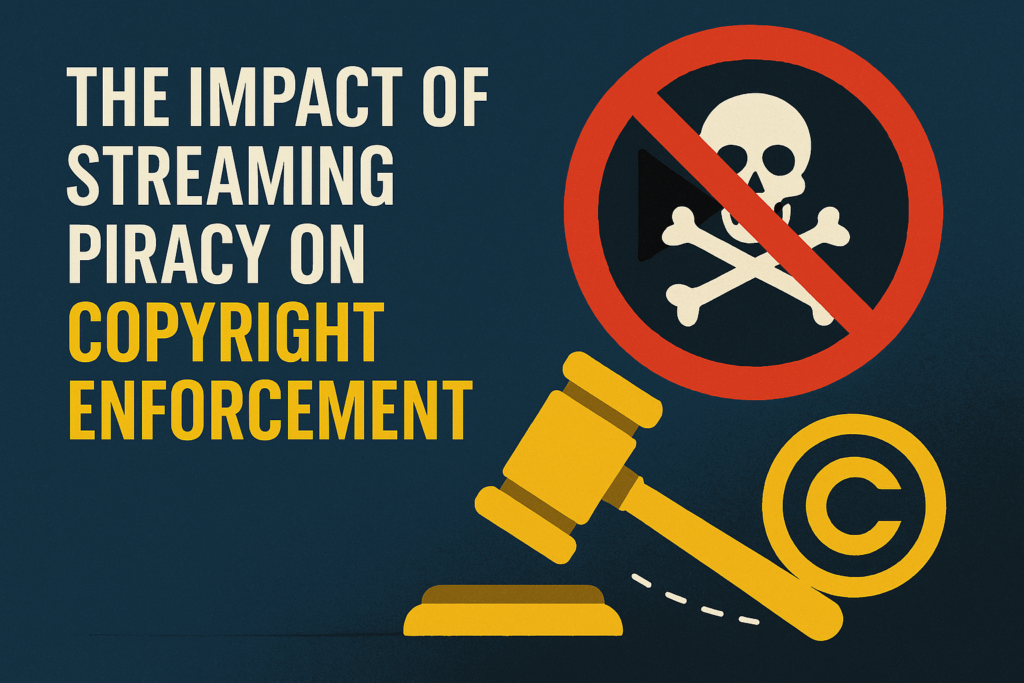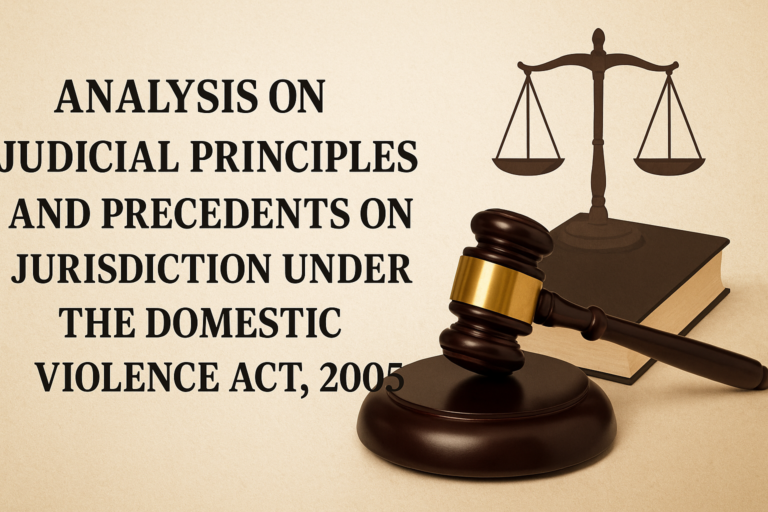
Maneta Milton, Author
ABSTRACT
The worldwide entertainment business, content producers, and legal frameworks are all impacted by streaming piracy, which has grown to be a serious obstacle to copyright enforcement. Because streaming piracy uses decentralised platforms, encrypted networks, and dynamic domain names, it is more difficult to detect and stop than classic piracy, which entails illegal downloads or tangible counterfeits. Because pirated information is so easily accessible, copyright holders lose a lot of money, less money is invested in content production, and enforcement organisations incur higher expenses. Jurisdictional complications, legal gaps, and technical innovations exploited by pirate networks are some of the challenges facing law enforcement. Pirates still take advantage of flaws in copyright systems in spite of strict legislation like the Digital Millennium Copyright Act (DMCA) and international collaboration under the WIPO Copyright Treaty. Improved digital watermarking, AI-driven content recognition, and website blocking are some of the measures used to stop streaming piracy. Raising consumer awareness and lowering the cost and accessibility of legal streaming services are other strategies in the battle against piracy. Even if enforcement strategies are changing, piracy is still a concern that requires ongoing technology advancements, more robust laws, and improved international cooperation to safeguard intellectual property rights and provide equitable income sharing in the digital economy.
INTRODUCTION
In the digital era, streaming piracy has become a significant problem that jeopardises the integrity of intellectual property rights and copyright enforcement. Unauthorised streaming of films, TV series, live sports, and music has become commonplace due to the quick development of high-speed internet and the increasing availability of digital material. Streaming piracy enables users to access copyrighted information in real-time without saving files on their devices, in contrast to traditional piracy, which entails illegal downloads. Because unlawful streaming sites may operate across numerous jurisdictions and take advantage of legal loopholes, policing becomes increasingly challenging. Streaming piracy causes enormous financial losses for the entertainment sector. Online piracy damages the U.S. economy at least $29.2 billion in lost income each year, with streaming piracy contributing significantly to this loss, according to a 2022 analysis by the Global Innovation Policy Center¹. Similar to this, a Motion Picture Association (MPA) research claims that millions of people use unauthorised streaming services globally, deterring prospective customers from using reputable services like Netflix, Amazon Prime, and Disney+².[1]
Stricter anti-piracy legislation, ISP-level website blocking, and AI-based content identification technologies are just a few of the proactive steps being taken by governments and copyright enforcement organisations to address this problem. Nevertheless, in order to avoid discovery, streaming pirate networks keep developing, including proxy servers, sophisticated encryption, and dynamic domain name changes. Furthermore, several websites contend that they just offer links to third-party sources rather than hosting copyrighted content, making the legal framework surrounding streaming piracy still complicated. Addressing streaming piracy necessitates a multifaceted strategy encompassing legal, technological, and commercial tactics as the digital world continues to change. Protecting intellectual property rights in the digital economy requires bolstering global collaboration, improving cybersecurity, and encouraging reasonably priced legal options.[2]
CHALLENGES IN COMBACTING STREAMING PIRACY
Effective copyright enforcement is hampered by a number of issues, even efforts to stop streaming piracy. These difficulties are brought on by jurisdictional complications, legal loopholes, technical developments, and the rising desire for free material from consumers.[3]
Legal and Jurisdictional Obstacles
Since streaming piracy runs across several jurisdictions, enforcement is challenging. Countries with weak intellectual property (IP) laws or little cooperation in international copyright enforcement host a large number of pirated websites¹. Legal measures against offenders are made more difficult by the absence of standardised international anti-piracy rules.[4]
Avoidable Technological Strategies
To avoid discovery, pirates employ advanced techniques including proxy servers, mirror sites, and encrypted peer-to-peer networks². Almost immediately after police shut down illicit streaming websites, new ones appear. Furthermore, some platforms pose as legitimate streaming services, which makes compliance much more difficult.[5]
Legal Difficulties in Downloading vs. Streaming
In many places, streaming piracy is a legal grey area, in contrast to classic piracy, which entails downloading copyrighted content. By taking advantage of legal loopholes, some operators assert that they just connect consumers to other sources rather than hosting illicit content³. Because courts may find it difficult to determine direct culpability, this makes prosecutions more difficult.[6]
Enforcement’s Economic Costs
It is expensive to enforce copyright rules, necessitating ongoing investments in cybersecurity, anti-piracy software, and legal measures. Every year, law enforcement and media organisations spend millions to find and stop illicit activities. Pirates, however, are fast to adapt and frequently surpass law police.
Demand and Consumer Behaviour
Due to the exorbitant membership fees for legal platforms or the restricted availability of material in some areas, many users resort to illicit streaming. Because of this consumer behaviour, the pirate ecosystem is maintained, making it more difficult to remove the issue.[7]
EFFECTIVENESS OF THE EXISTING LEGAL SYSTEM
India has put in place a number of rules to stop streaming piracy, but problems still exist because of changing technology and enforcement issues. The Copyright Act of 1957, which was amended in 2012 to provide harsher penalties for online infringement, including up to three years in prison and monetary fines, is the main piece of legislation regulating piracy. Another important tool in the fight against piracy is the Information Technology (IT) Act of 2000, which gives the government the authority to prohibit websites under Section 69A. Furthermore, unlicensed camcording is a major source of pirated content for illicit streaming services, and it is especially targeted by the Cinematograph (Amendment) Act, 2019. [8]Even with these legal protections, enforcement is still quite difficult. Since many pirate websites are based in countries with lax intellectual property regulations, it is challenging to prosecute them. The tracking and closure of such platforms are made more difficult by the use of VPNs, proxy servers, and dynamic domain names⁴. The long-term efficacy of John Doe orders to preemptively prohibit infringing websites is sometimes undermined by the quick emergence of new mirror sites, even though Indian courts often issue them. The legal uncertainty surrounding internet streaming is another significant problem. Some platforms say they just offer links to third-party sources and do not store copyrighted content, taking advantage of legal loopholes.[9]Due to expensive membership fees and limited access to certain material, many users resort to illicit streaming services, which contributes to the persistence of piracy. Many people do not consider streaming pirated video to be illegal, and public awareness of copyright breaches is still low. Digital watermarking, AI-driven content recognition, and takedown notices are some of the tactics used by industry participants, such as movie studios and streaming services, to try to stop piracy. To combat pirate networks that operate outside of India, cooperation with international anti-piracy organisations has also been bolstered.
India must implement a multifaceted strategy that includes expanded consumer awareness campaigns, tougher sanctions for digital piracy, cybersecurity technology breakthroughs, and improved international collaboration in order to improve the efficacy of copyright enforcement. Although current legislation offers a solid basis, ongoing changes in pirate methods necessitate flexible legal and enforcement approaches in order to successfully protect intellectual property rights.
COMPREHENSIVE STRATERGIES TO COMBACT THE ISSUE
It takes a mix of technological, legal, and awareness-raising tactics to combat streaming piracy. Deterrence can be increased by fortifying copyright laws with harsher sanctions for online infringement, quicker court cases, and improved coordination amongst law enforcement. Real-time blocking of illegal websites must be implemented by governments in close collaboration with ISPs, while dynamic injunctions must be maintained to stop mirror sites from returning. More efficient detection and removal of pirated content may be possible with developments in digital watermarking and AI-driven content monitoring. Campaigns for public awareness should inform customers about the legal repercussions of piracy and advocate for accessible, reasonably priced lawful streaming options. Subscription-based platforms can lower the motivation to look for unlawful solutions by implementing adjustable price schemes to accommodate various economic sectors. Dismantling cross-jurisdictional pirate networks requires cooperation between national and international authorities, with extradition treaties and coordinated enforcement being essential. Legitimate platforms may be encouraged to aggressively fight piracy by industry-led measures like self-regulation tools and voluntary anti-piracy rules. Transparency and traceability may also be improved by encouraging innovation in content distribution, such as blockchain-based copyright management. A multifaceted strategy that incorporates legal, technological, and financial incentives is necessary to successfully defend intellectual property rights as piracy continues to change.[10]
LEGAL REFORMS REQUIRED
For India to successfully tackle streaming piracy, substantial legislative measures are required. Legal loopholes that let websites to function by simply linking to stolen information should be closed by amending the Copyright Act of 1957 to specifically criminalise unauthorised streaming. For intellectual property infringement, fast-track courts can guarantee deterrent and punishment more quickly. Repeat offenders and pirate network operators should face harsher punishments, such as increased fines and longer jail terms.
To provide law enforcement organisations additional ability to monitor and take down pirate websites more effectively, the Information Technology (IT) Act of 2000 should be amended. In order to automatically extend court orders to freshly appearing mirror sites, dynamic injunctions ought to be implemented. Real-time filtering of illicit content may be made easier with improved collaboration between ISPs, streaming services, and the authorities.
Furthermore, in order to combat the worldwide scope of streaming piracy, cross-border legal frameworks had to be reinforced. Effective action against criminals operating outside of Indian jurisdiction will be made possible by extradition accords and international collaboration with anti-piracy groups. Lastly, a regulatory agency for the protection of digital content might be set up to supervise adherence and plan enforcement actions. A stronger foundation for preventing piracy and defending intellectual property rights will be established by these legislative measures.
CONCLUSION
Despite current legal frameworks, technical solutions, and enforcement efforts, streaming piracy continues to pose a serious concern. Despite India’s robust copyright regulations, pirate networks flourish due to legal loopholes and enforcement challenges. Copyright protection may be improved by fortifying legal measures, putting dynamic injunctions into place, and encouraging stakeholder collaboration. Consumer reliance on illicit platforms will decline with increased public knowledge and more reasonably priced streaming options. Furthermore, utilising AI-powered surveillance and global cooperation can aid in more successfully thwarting piracy. Because digital piracy is developing so quickly, protecting intellectual property rights requires a proactive and flexible legal strategy. India can establish a more effective anti-piracy policy that will safeguard creative industries and allow for the legitimate distribution of information in the digital age by combining stronger legislation, technical developments, and international collaboration.
[1] Global Innovation Policy Center (2022). Impacts of Digital Piracy on the U.S. Economy. Retrieved from https://www.theglobalipcenter.com
[2] Motion Picture Association (2023). The Impact of Streaming Piracy on the Entertainment Industry. Retrieved from https://www.motionpictures.org
[3] WIPO (2023). International Challenges in Copyright Enforcement. Retrieved from https://www.wipo.int
[4] Digital Citizens Alliance (2022). Piracy’s Evolving Tactics. Retrieved from https://www.digitalcitizensalliance.org
[5] European Commission (2023). Legal Challenges in Online Piracy Enforcement. Retrieved from https://ec.europa.eu
[6] Motion Picture Association (2022). The Cost of Copyright Infringement. Retrieved from https://www.motionpictures.org
[7] Global Innovation Policy Center (2023). Consumer Trends and Digital Piracy. Retrieved from https://www.theglobalipcenter.com
[8] The Information Technology Act, 2000, Government of India. Retrieved from https://www.meity.gov.in
[9] Economic Times (2023). Challenges in Tackling Digital Piracy in India. Retrieved from https://economictimes.indiatimes.com
[10] World Intellectual Property Organization (2023). Global Strategies for Combating Digital Piracy. Retrieved from https://www.wipo.int










